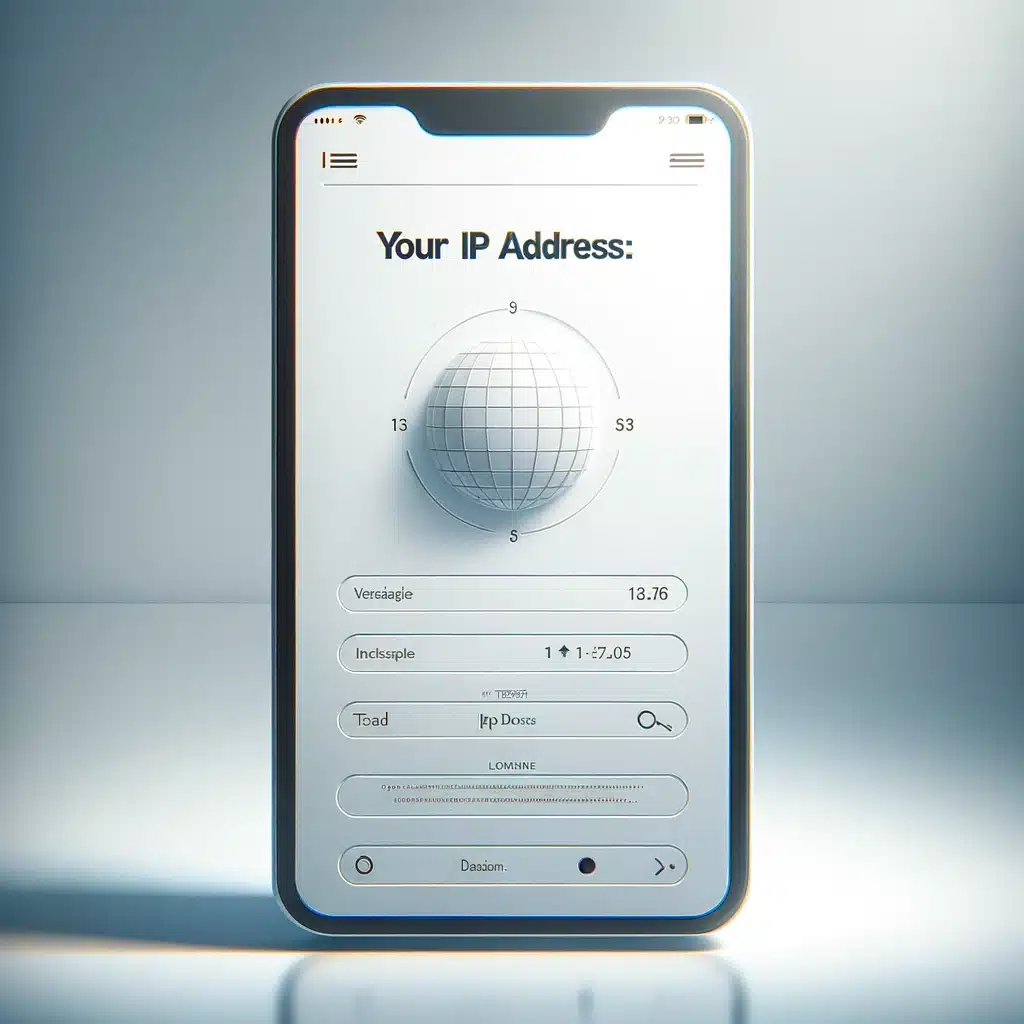- Home
- Blog
- Downloads
- Forum
- Games
- FAQs
- News
- Events
- Shop
- Code
- Contact
About Us
Have questions? Reach out to us anytime through our Contact page.
Read our Privacy Policy, Legal Disclaimer, and Site Content Policy to understand how we protect your data, your rights, and the rules for using our site.
Schedule a meeting with us at your convenience.
Our Products & Services
Explore our full range of products and services designed to meet your needs.
Get fast, reliable support from our helpdesk team—here when you need us.
Enter Virii8Social — your space to build, connect, and bring communities to life.
Get a free website—just add a link back to us.
Your hub for all things WordPress—guides, tips, tools, themes, and tutorials in one place.
Let us help you set up WordPress—fast, clean, and done right.
JBD After Hour Notary – Reliable notary services, available when others aren’t.
Gain guidance and insight from higher realms to illuminate your path forward.
An autonomous driving car with sentinel-like abilities uses a constantly vigilant, multi-sensor AI system that not only navigates and avoids hazards but also actively anticipates threats, protects occupants, and adapts in real time to maintain maximum safety and situational awareness.
- Health
- About Us
- Login
- Register
Table of Contents
Toggle- What Is My IP?
- If you can see your location, and IPs below that means you can be tracked. Please consider a VPN service.
- IPv4
- IPv6
- Technical Protocols and Standards
- Dynamic vs. Static IP Addresses
- DNS (Domain Name System)
- IP Address Management (IPAM)
- IPv4 vs. IPv6 Adoption
- Security Considerations
- Internet Governance and IP Address Allocation
- Network Design and Architecture
- Internet of Things (IoT)
- Outside of our free IP service.
- On Windows
- On macOS
- On Linux
- On Android
- On iOS (iPhone/iPad)
- Online IP Check (Public IP)
- How to Find IP Address on Mac
What Is My IP?
If you can see your location, and IPs below that means you can be tracked. Please consider a VPN service.
Network Info
An IP address, which stands for Internet Protocol address, is a unique identifier assigned to each device connected to a network that uses the Internet Protocol for communication. This address allows devices to send and receive data over the Internet or a local network, ensuring that the data reaches the correct destination. There are two versions of IP addresses:
- IPv4 (Internet Protocol version 4): This is the most widely used version. It uses a 32-bit address scheme allowing for a total of around 4.3 billion unique addresses. An IPv4 address is typically shown as four decimal numbers separated by dots, for example, 192.168.1.1.
- IPv6 (Internet Protocol version 6): Due to the limited number of addresses available with IPv4 and the growing number of Internet users, IPv6 was developed. It uses a 128-bit address scheme, significantly increasing the number of available addresses. An IPv6 address is represented by eight groups of four hexadecimal digits separated by colons, for example, 2001:0db8:85a3:0000:0000:8a2e:0370:7334.
IP addresses are fundamental to the functioning of the internet, enabling devices to communicate with each other by providing a way to identify and locate them on a network.
To provide a more detailed and technical explanation, let’s delve into the components and functions of IP addresses, as well as the differences between IPv4 and IPv6, including aspects like address space, representation, and subnetting.
IPv4
- Address Space: IPv4 uses a 32-bit address space, which theoretically allows for approximately 4.3 billion unique addresses. However, the actual number of available public addresses is lower due to reserved addresses for private networks (e.g., 192.168.x.x, 10.x.x.x), multicast addresses, and other special purposes.
- Representation: An IPv4 address is represented as four decimal numbers, each ranging from 0 to 255, separated by dots (e.g., 192.168.1.1). This format is known as “dotted decimal notation.”
- Subnetting: IPv4 addresses can be divided into subnetworks to organize and manage network traffic more efficiently. This is achieved by using a subnet mask, which when applied to an IP address, specifies the network’s portion and the host within that network. Subnetting helps in reducing broadcast traffic and allocating IP addresses more efficiently within organizations.
- Address Exhaustion: The limited address space of IPv4 has led to address exhaustion, which is mitigated through techniques like Network Address Translation (NAT), allowing multiple devices on a private network to share a single public IP address.
IPv6
- Address Space: IPv6 addresses are 128 bits long, significantly increasing the address space to 3.4 x 10^38 possible addresses. This vast space accommodates the growing number of devices and eliminates the need for NAT, allowing each device to have a unique global IP address.
- Representation: IPv6 addresses are represented as eight groups of four hexadecimal digits (e.g., 2001:0db8:85a3:0000:0000:8a2e:0370:7334), with each group representing 16 bits of the address. To simplify notation, leading zeros within a group can be omitted, and one sequence of zero groups can be replaced with “::”.
- Subnetting and Address Allocation: IPv6 also supports subnetting, but due to the larger address space, it allows for a more hierarchical and efficient allocation of addresses. The typical subnet size for a local network is /64, which leaves the second half of the address for interface identification.
- Additional Features: IPv6 includes features designed to improve performance and security over IPv4, such as simplified packet header for more efficient processing, built-in support for quality of service (QoS), and mandatory support for IPsec for secure communication.
- Transition Mechanisms: Various technologies have been developed to ensure a smooth transition from IPv4 to IPv6, including dual-stack systems (where devices run both IPv4 and IPv6 simultaneously), tunneling (encapsulating IPv6 traffic within IPv4 packets), and translation (converting between IPv4 and IPv6 packets).
Technical Protocols and Standards
IP addresses are defined and utilized by various technical standards and protocols to ensure reliable, efficient, and secure communication over the internet and other IP networks. These include:
- TCP/IP (Transmission Control Protocol/Internet Protocol): The foundational protocols for the internet, where IP handles addressing and routing of packets, and TCP ensures reliable transmission of data.
- IPsec (Internet Protocol Security): A suite of protocols for securing IP communications by authenticating and encrypting each IP packet in a data stream.
- ICMP (Internet Control Message Protocol) and ICMPv6 (for IPv6): Used by network devices to send error messages and operational information indicating, for example, that a requested service is not available or that a host or router could not be reached.
IP addresses are crucial for the operation of the internet and private networks, enabling devices to communicate and exchange data globally.
Understanding IP addresses and their role in networking lays a solid foundation, but there are several additional aspects and related topics that can deepen your knowledge and enhance your grasp of how networks operate. Here are a few key areas:
Dynamic vs. Static IP Addresses
- Dynamic IP Addresses: These are temporarily assigned to a device for the duration of its connection to the network. Dynamic IPs are commonly used by ISPs (Internet Service Providers) for residential customers and are managed via DHCP (Dynamic Host Configuration Protocol).
- Static IP Addresses: These are permanently assigned to a device or service. Static IPs are essential for servers hosting websites, email servers, or any service that requires a constant address.
DNS (Domain Name System)
- The DNS translates human-readable domain names (like
www.example.com) into IP addresses that computers use to identify each other on the network. Without DNS, we would have to remember the IP addresses of every website we want to visit.
IP Address Management (IPAM)
- As networks grow in size and complexity, managing the allocation, classification, and tracking of IP addresses becomes crucial. IPAM tools help network administrators efficiently manage the IP space within their networks.
IPv4 vs. IPv6 Adoption
- Despite IPv6’s advantages and the exhaustion of IPv4 addresses, IPv4 remains widely used due to the vast infrastructure built around it. Transition strategies like dual stacking, tunneling, and translation mechanisms are critical for the gradual migration to IPv6.
Security Considerations
- IP addresses can be a vector for security threats, such as DDoS attacks or IP spoofing. Implementing security measures like firewalls, intrusion detection systems, and secure VPNs, along with adopting IPv6’s enhanced security features, is essential for protecting network resources.
Internet Governance and IP Address Allocation
- Organizations like the Internet Assigned Numbers Authority (IANA) and regional Internet registries (RIRs) oversee the allocation and management of IP addresses globally, ensuring fair distribution and addressing policy development.
Network Design and Architecture
- Understanding how IP addresses fit into broader network design and architecture, including routing, subnetting strategies, and the use of VLANs (Virtual LANs), can help optimize network performance and scalability.
Internet of Things (IoT)
- With the proliferation of IoT devices, efficient IP address management and the transition to IPv6 are becoming increasingly important to accommodate the vast number of connected devices.
By exploring these areas, you can gain a more comprehensive understanding of IP addresses and their pivotal role in networking and internet technology. Whether you’re a computer enthusiast, a network administrator, or just curious about how the internet works, these topics provide valuable insights into the complex, interconnected world of digital communication.
Outside of our free IP service.
Finding your IP address can vary depending on the device and operating system you are using. Here are methods for finding your IP address on various platforms:
On Windows
- Using the Command Prompt:
- Press
Win + R, typecmd, and press Enter to open the Command Prompt. - Type
ipconfigand press Enter. Your IP address will be listed under “IPv4 Address” for your active network connection.
- Press
- Through Network Settings:
- Go to Settings > Network & Internet > Status.
- Click on “View your network properties”. Your IP address will be listed under “IPv4 address”.
On macOS
- Using Terminal:
- Open Terminal from Applications > Utilities.
- Type
ifconfigand press Enter. You will find your IP address listed under “inet” for your active network interface (e.g., en0 for Ethernet, en1 for Wi-Fi).
- Through System Preferences:
- Go to Apple menu > System Preferences > Network.
- Select your active connection from the list (e.g., Wi-Fi, Ethernet) and your IP address will be displayed.
On Linux
- Using the Terminal:
- Open a terminal window.
- Type
ip addrorifconfigand press Enter. Your IP address will be listed under “inet” for your active network interfaces.
- Through Network Manager (GUI method):
- Navigate to your network settings through the system menu.
- Select your network connection, and you might find the IP address listed in the connection details or settings.
On Android
- Go to Settings > Wi-Fi & network > Wi-Fi.
- Tap on the network you are connected to.
- Look for your IP address in the network details.
On iOS (iPhone/iPad)
- Go to Settings > Wi-Fi.
- Tap on the “i” icon next to the Wi-Fi network you’re connected to.
- Your IP address will be listed under the “IPv4 Address” section.
Online IP Check (Public IP)
- You can also find your public IP address (the one the Internet sees) by searching “What is my IP” in a search engine or using websites like
whatismyip.com. This will show your public IP address, which may be different from your local (private) IP address if you’re behind a router performing NAT (Network Address Translation).
Remember, the methods above will mostly show you your local IP address within your home or office network (private IP). For your public IP address, using an online tool or website is the simplest method.
How to Find IP Address on Mac
Every device connected to the Internet has an IP address. Though these addresses are meant for communication and identification between devices, it’s always possible to encounter issues with your IP address. You can have problems whether it be on a Mac computer, a Windows computer, an iPhone, a Roku device, or even a website – all websites have IP addresses. Knowing how to find an IP address on a Mac can help you troubleshoot any issues you have. Whether it be a conflict between IPs, network connectivity issues, or other problems, learn how to find the IP address of Macs to move forward in fixing these issues.
Finding an IP address on a Mac
You can find your public IP address on WhatIsMyIP through your browser, but the local IP address assigned to your Mac is located in your device’s settings. To get the IP address of Macbooks, follow these steps.
1. Select the Apple menu in the upper left corner of the screen and click System Settings.
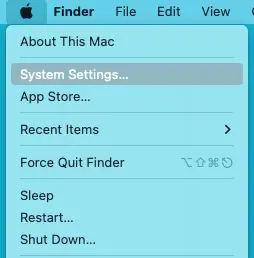
2. Click the Network from the System menu.
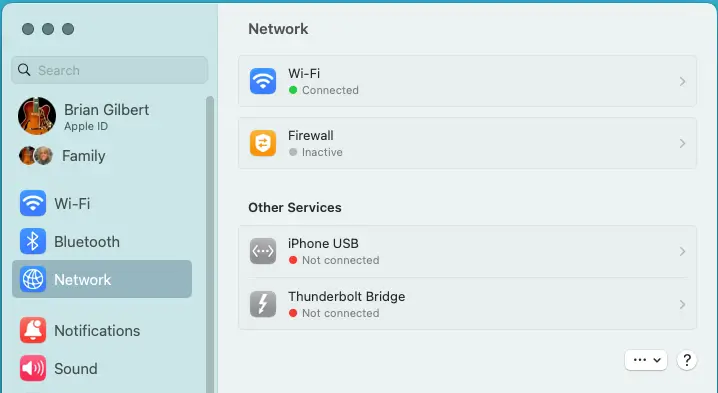
3. Select the appropriate connection and click Details. The example shows WiFi as the selected choice.
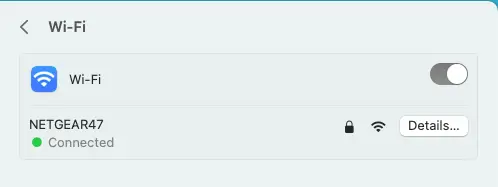
4. You can see your IP address listed on the screen next to IP Address. In this example, the IP address of this device is 192.168.1.19, which is a private IP address. On the same screen, you can also see your router IP address which is 192.168.1.1.
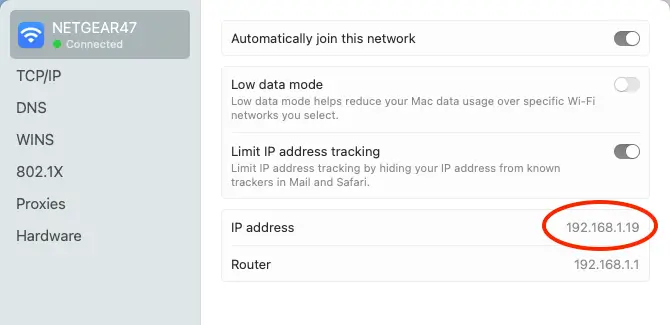
What to do if you’re experiencing IP conflicts
If you are experiencing any of the aforementioned IP conflicts or network connectivity issues, try the following once you’ve found your IP address.
- Make sure you have a solid Internet connection. If necessary, try a wired connection.
- Attempt to power cycle your Mac or MacOS device.
- If there is a certain app giving you problems, restart the app altogether by closing and reopening it. Begin again from the Step 1.
- If you entered the IP address manually, whether internal IP address or external IP address, ensure you entered it correctly.
If you’re on a home network, and none of the above suggestions fix the problem, try disconnecting from the network and turning off all other devices connected to it, including the router and modem. Wait a few minutes, turn the devices back on, and retry the steps above.
How do you change an IP address on a Mac?
For privacy reasons, you may want to change your IP address altogether. If this is the case, you can use a VPN to easily hide your IP and get improved protection online. You can also change an IP address on a Mac through the following steps:
- Click the Apple icon and go to System Settings.
- Click Network.
- Select your network and click Details….
- Select the TCP/IP tab.
- Under Configure IPv4, select Manually. Enter your new IP address and hit OK. Keep in mind, if your IP is assigned by your router, this will only change your local IP address. If your IP is assigned directly to your device from your ISP, manually changing your IP address could cause an IP conflict and hinder your internet connection.
If you want to check the IP address of a Mac, you can do it in the System Settings as well. Additionally, remember to consistently back up your Mac with Time Machine to protect your data. Learning how to find a Mac IP address can help you troubleshoot any issues you might be having, whether it be with Internet service, a network connection, or something else.
Yes, your IP address can reveal some information about you, primarily to entities with the necessary resources or legal authority. Here’s a breakdown of what can generally be determined from your IP address and the limitations:
Location Information
- General Location: Your IP address can reveal your general location, such as the city or region you’re in. This is because IP addresses are distributed in blocks that are allocated to specific geographic regions.
- Accuracy: The location accuracy can vary significantly. In some cases, it might only pinpoint the city or the ISP’s location rather than your exact address.
ISP Information
- Identification of ISP: Anyone can easily find out which Internet Service Provider (ISP) owns an IP address. This information is publicly available through various online tools.
Legal and Law Enforcement
- ISP Records: ISPs keep logs that connect IP addresses to customer accounts. With a legal process, such as a court order, law enforcement can compel an ISP to provide the customer information associated with an IP address at a specific time.
- Limitations without Legal Authority: Without a court order, it’s challenging for a regular individual to obtain personal information linked to an IP address from an ISP.
Privacy Concerns
- Online Tracking and Profiles: Advertisers and websites might use your IP address, among other data, to track your activity online and build profiles based on your interests and behavior.
- Potential Risks: If someone malicious has your IP address, they might attempt activities like port scanning to find vulnerabilities in your network or perform targeted attacks. However, for most users, the risk is relatively low, especially with a secure, updated system and a router with a firewall.
Protection Measures
- VPNs and Proxies: Using a VPN (Virtual Private Network) or a proxy can mask your real IP address, providing you with more anonymity online. These services route your internet traffic through a different IP address, hiding your actual location and ISP information.
- Dynamic IPs: Many ISPs assign dynamic IP addresses, which change periodically. This can naturally offer a degree of privacy since your IP address doesn’t permanently tie to your online activities.
In summary, while your IP address can reveal some information about you, the extent of what can be discovered depends on the resources and authority of the entity looking to find you. For most people, the risks associated with someone having your IP address are relatively low, especially with proper security measures in place.
what is an IP Address? // You SUCK at Subnetting // EP 1
privacy, security, IP address, tracking, internet safety, cyber security, online identity, network identification, digital footprint, location tracking, personal information, internet protocol, online anonymity, data protection, user traceability, web surveillance, IP tracing, cybersecurity threats, network privacy, IP geolocation, online tracking, IP lookup, internet service provider, ISP, digital privacy, network security, IP monitoring, online privacy, digital tracking, public IP address, private IP address, IP masking, VPN (Virtual Private Network), IP anonymization, online behavior tracking, cyberstalking, internet footprint, network tracing, data privacy, IP tracking technology, internet usage monitoring, online exposure, digital vulnerability, network address translation (NAT), online safety, personal data security, IP address detection, internet anonymity, cyber safety, online presence management, internet identity, encrypted connections, proxy servers, digital breadcrumbs, IP filtering, network vulnerability, IP address blocking, cyber investigations, IP spoofing, digital surveillance, IP address hiding, online security measures, network access control, geo-IP restrictions, internet protocol security (IPsec), threat intelligence, digital identity protection, network packet analysis, online risk management, privacy-enhancing technologies, IP address leasing, dynamic IP addresses, static IP addresses, deep packet inspection, online footprint reduction, cybersecurity protocols, IP address encryption, secure browsing, internet governance, data breach prevention, IP address management, digital traceability, network perimeter security, online behavior analysis, cyber anonymity, IP address forensics, network anomaly detection, personal cybersecurity, internet traffic analysis, secure network architecture, IP address confidentiality, online data protection laws, cyber footprint minimization, IP address audit, network identity management, online vulnerability assessment, privacy settings management, digital ethics, internet connection security, network monitoring tools, digital safety practices, IP geofencing, secure IP communication, network encryption, internet privacy laws, personal information security, digital self-defense, internet usage policies, network access privacy, cyber privacy strategies, digital network security, internet address management, personal network safety, IP address security measures, digital privacy rights, online surveillance countermeasures, network security awareness, secure internet protocols, cyber protection measures, digital information security, private browsing techniques, internet user privacy, network data control, secure online identity, internet privacy tools, network security solutions, personal data protection strategies, online privacy enhancements, secure digital footprint
Related Posts:
JBD After hour notary – afterhournotary.com
How Can You Troubleshoot Your Refrigerator Like an HVAC Technician?
Top 5 Essential Difference Between www and http You Should Know
How Many Weeks Are There in a Year?
How many days until Christmas?
Is Your Windows Computer Sound Not Working? Troubleshooting Tips to Fix It
North Korean Hackers Use ELECTRICFISH Malware to Steal Data
Comprehensive Guide to Precision Metal Finishing Techniques – Two to your one, all day, everyday.
- Answers to your questions
- Artificial Intelligence
- Artificial Weather
- Assembly Language
- Business
- C++
- CRA (Canada Revenue)
- Cybersecurity
- DIY Projects and Hacks
- Gadget and Tech Reviews
- Health
- Java
- JavaScript
- Macro Automation Recording
- Microsoft Windows 10
- Python
- SEO
- Tech News Q&E
- Troubleshooting and Support
- Visual Basic .NET
- WordPress FAQ


